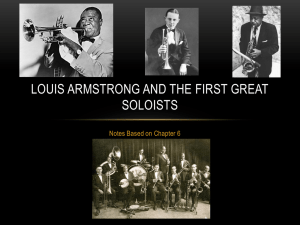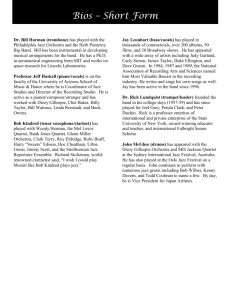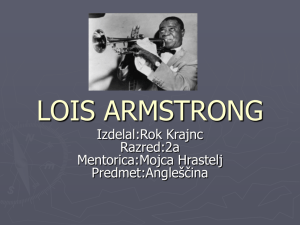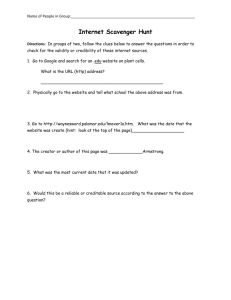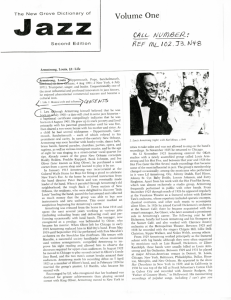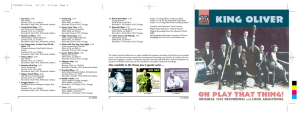armstrong
advertisement
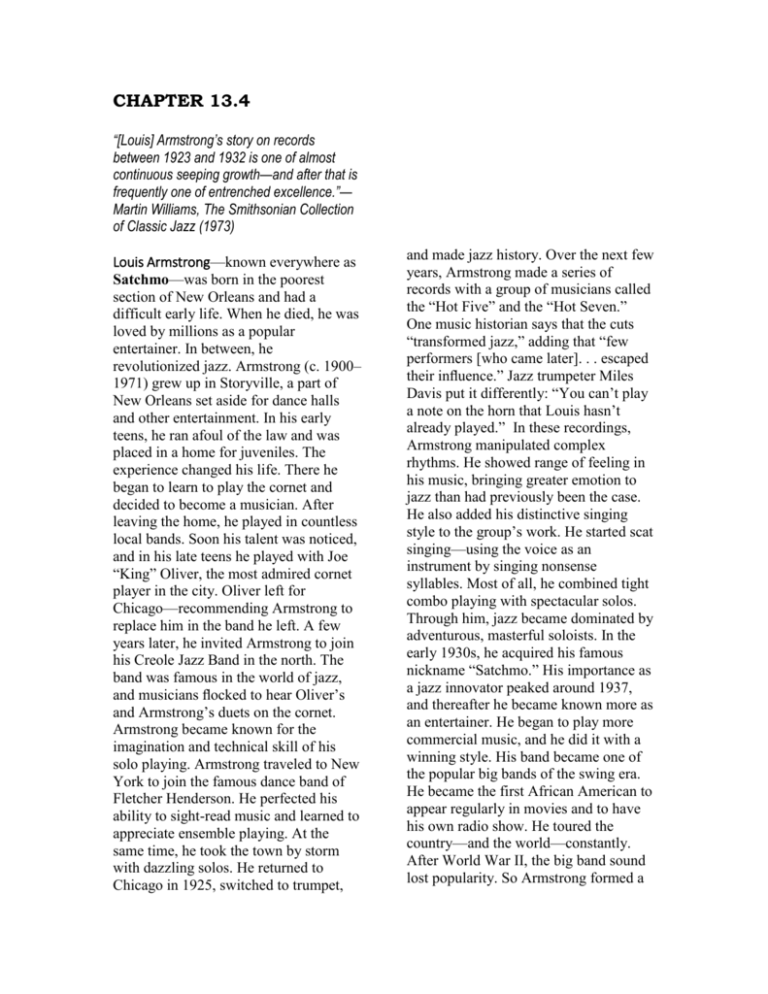
CHAPTER 13.4 “[Louis] Armstrong’s story on records between 1923 and 1932 is one of almost continuous seeping growth—and after that is frequently one of entrenched excellence.”— Martin Williams, The Smithsonian Collection of Classic Jazz (1973) Louis Armstrong—known everywhere as Satchmo—was born in the poorest section of New Orleans and had a difficult early life. When he died, he was loved by millions as a popular entertainer. In between, he revolutionized jazz. Armstrong (c. 1900– 1971) grew up in Storyville, a part of New Orleans set aside for dance halls and other entertainment. In his early teens, he ran afoul of the law and was placed in a home for juveniles. The experience changed his life. There he began to learn to play the cornet and decided to become a musician. After leaving the home, he played in countless local bands. Soon his talent was noticed, and in his late teens he played with Joe “King” Oliver, the most admired cornet player in the city. Oliver left for Chicago—recommending Armstrong to replace him in the band he left. A few years later, he invited Armstrong to join his Creole Jazz Band in the north. The band was famous in the world of jazz, and musicians flocked to hear Oliver’s and Armstrong’s duets on the cornet. Armstrong became known for the imagination and technical skill of his solo playing. Armstrong traveled to New York to join the famous dance band of Fletcher Henderson. He perfected his ability to sight-read music and learned to appreciate ensemble playing. At the same time, he took the town by storm with dazzling solos. He returned to Chicago in 1925, switched to trumpet, and made jazz history. Over the next few years, Armstrong made a series of records with a group of musicians called the “Hot Five” and the “Hot Seven.” One music historian says that the cuts “transformed jazz,” adding that “few performers [who came later]. . . escaped their influence.” Jazz trumpeter Miles Davis put it differently: “You can’t play a note on the horn that Louis hasn’t already played.” In these recordings, Armstrong manipulated complex rhythms. He showed range of feeling in his music, bringing greater emotion to jazz than had previously been the case. He also added his distinctive singing style to the group’s work. He started scat singing—using the voice as an instrument by singing nonsense syllables. Most of all, he combined tight combo playing with spectacular solos. Through him, jazz became dominated by adventurous, masterful soloists. In the early 1930s, he acquired his famous nickname “Satchmo.” His importance as a jazz innovator peaked around 1937, and thereafter he became known more as an entertainer. He began to play more commercial music, and he did it with a winning style. His band became one of the popular big bands of the swing era. He became the first African American to appear regularly in movies and to have his own radio show. He toured the country—and the world—constantly. After World War II, the big band sound lost popularity. So Armstrong formed a small jazz combo called “Louis Armstrong and His All Stars.” He continued to delight audiences with his warm, joyful sound. As time passed, his lips became injured, so he played trumpet less and sang more. Even then, he could still thrill an audience with his playing. As one critic said, he “frequently created more pure jazz from straightforward statements of mediocre tunes than lesser players could produce from much better material.” Armstrong continued to be an entertainer through his sixties. In 1964, his version of “Hello, Dolly” even knocked the Beatles off the top of the pop-music charts for a while. While he closed his career as a popular musician, Satchmo’s lasting achievement was the impact he had on jazz. Questions: Answer on a separate sheet of paper. 1.) How did his experience with the Fletcher Henderson band help Armstrong musically? 2.) What made Armstrong’s jazz style special and influential? 3.) Why was Armstrong’s wide popularity unusual?
